|
|
|
Sort Order |
|
|
|
Items / Page
|
|
|
|
|
|
|
| Srl | Item |
| 1 |
ID:
117870
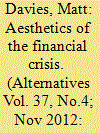

|
|
|
|
|
| Publication |
2012.
|
| Summary/Abstract |
The ways that financialization has contributed to the technocratic and antipolitical management of economies have become ever more evident in the wake of the financial crisis that commenced in the autumn of 2007. This bracketing and suspension of politics occurs in various ways but significantly, it does so through the obscuring of work as a moment of economic life. If economics has been complicit in this antipolitics, can an aesthetic approach to financialization shed light on how work is rendered invisible? This article analyzes four short film clips all distributed through YouTube to show not only how their visual and narrative elements organize subjectivities for an antipolitics of finance but also to find in the popular aesthetic a different "distribution of the sensible" that permits moments of suspension or rupture that can politicize financialized subjectivity and begin to recover a politics of work.
|
|
|
|
|
|
|
|
|
|
|
|
|
|
|
|
| 2 |
ID:
101928
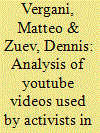

|
|
|
|
|
| Publication |
2011.
|
| Summary/Abstract |
This paper explores the uses of YouTube by Uyghur nationalist movement activists and studies various ideological codes used by different communities to promote their messages. It argues that several ideological codes are produced in order to challenge the dominant ideologies promoted by the Chinese government, which create a ground for Uyghur 'imagined solidarity' across physical borders. Analysis of the production of audio-visual messages by the dispersed ethnic group provides an important window into how ethnic identity is forged by means of Web 2.0.
|
|
|
|
|
|
|
|
|
|
|
|
|
|
|
|
| 3 |
ID:
096375


|
|
|
|
|
| Publication |
2010.
|
| Summary/Abstract |
From the establishment of the United States Postal Service and the invention of the telegram, to the introduction of C-SPAN and the explosion of the Internet, the development of new communication technologies has always affected the functioning of Congress. Not surprisingly, recent innovations such as e-mail and social networking have spurred Congress to alter the way it operates as an institution, and rethink the manner in which it engages the public. In this brief examination, I discuss recent changes in congressional behavior and practices due to technological innovation, specifically the proliferation of social networking Web sites. Then, I cautiously predict future trends in the use of social networking and related technologies as they become more integrated in congressional offices and increase the capacity for more robust internal and constituent communications over time.
|
|
|
|
|
|
|
|
|
|
|
|
|
|
|
|
| 4 |
ID:
189228


|
|
|
|
|
| Summary/Abstract |
As the Chinese state ramps up its efforts in international narrative competitions, Chinese media master new genres and test different visual languages on global social media platforms. The diverse content they produce provides a new source of information about China’s self-representations intended for foreigners and thus provides a condensed answer to one of the key questions of China’s foreign policy: Who is China? It also responds to the question that many observers outside of China pose: What does China’s rise mean for the rest of the world? To explain how Chinese state media use new mediums to (re)imagine China and narrate its relations with the world, this study focuses on the entertainment visual content they posted on YouTube between 2013 and 2019 to introduce and endorse Xi Jinping’s Belt and Road initiative (BRI). Using a critical discursive methodology, it decodes text-visual frames created by Chinese media to bring to the fore components of BRI’s discursive politics that are imperceptible in formal diplomatic communications.
|
|
|
|
|
|
|
|
|
|
|
|
|
|
|
|
| 5 |
ID:
093009
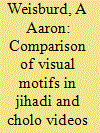

|
|
|
|
|
| Publication |
2009.
|
| Summary/Abstract |
Homegrown Sunni extremists (jihadis) and Latin American street gang members (cholos) represent potential threats to national security. Both groups are known to inhabit the video- sharing website YouTube. Videos representative of each group were selected at random, and the visual motifs in the videos were categorized. Findings suggest similarities and differences between the two groups that may have significance for how practitioners address each threat, and for determining the likelihood that the two groups may begin to work in concert. The portraits that emerge of jihadis and cholos may assist in developing strategies to counter the violence perpetrated by each.
|
|
|
|
|
|
|
|
|
|
|
|
|
|
|
|
| 6 |
ID:
123239


|
|
|
| 7 |
ID:
179091


|
|
|
|
|
| Summary/Abstract |
Recent scholarship claims that narratives and images of war have political effects, not simply because of their content and ‘form’, but because of their affective and emotional ‘forces’. Yet, International Relations scholars rarely explore how audiences respond to narratives and images of war in their research. Addressing this gap, this paper combines discourse analysis of RT (formerly Russia Today) ‘breaking news’ YouTube videos of Russian military intervention in Syria with analysis of 750 comments and social media interactions on those videos. Our findings demonstrate how RT layers moral and legal justifications for Russian intervention in multiple audio-visual formats, within a visual narrative of the conflict that relies on affective representations of key actors and events. Viewers largely approve of the content, replicate its core narratives and express emotions coherent with RT’s affective representation of the Syrian conflict. Audiences’ responses to these narratives and images of war were shaped by their affective investments in the identities and events portrayed on-screen. These affective investments are therefore crucial in understanding the political significance of images of armed conflict.
|
|
|
|
|
|
|
|
|
|
|
|
|
|
|
|
| 8 |
ID:
112170


|
|
|
|
|
| Publication |
2012.
|
| Summary/Abstract |
This paper explores what I call "online experiments in ethical affect" through an analysis of one popular Islamic genre: the short video segments of Friday sermons (khu?ub, s. khu?ba) placed on the video-sharing website YouTube. In my discussion of this media form, I give particular attention to the kind of devotional discourse and ethical socius that is enacted online around these taped performances: notably, the practices of appending written comments to specific videos, offering responses to comments left by others or criticisms directed at either the preacher or other commentators, and the act of creating links between khu?ba pages and other web-based content. In examining these practices, I want to look at the way some of the norms of ethical and devotional comportment associated with the khu?ba in the mosque carry over to the Internet context of khu?ba listening/viewing while also engendering novel forms of pious interaction, argument, and listening.
|
|
|
|
|
|
|
|
|
|
|
|
|
|
|
|
| 9 |
ID:
142048
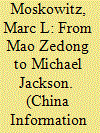

|
|
|
|
|
| Summary/Abstract |
There is an array of mash-up videos on YouTube, and its Chinese equivalent Tudou, that use visual footage from a Cultural Revolution performance with pop music soundtracks ranging from Michael Jackson’s ‘Beat It’ to the rap song ‘Ninja’ by Jay Chou, a Taiwanese Mandopop star. In merging temporal and regional sights and sounds in this manner, these videos playfully remap history and the contemporary moment. At first glance the commentary posted to these videos seems like little more than unreflexive praise or unrelated venting. Yet comparing the conversations that take place on YouTube and Tudou reveals a good deal about the cultural and historical understandings of the people making the comments. In the following pages I will analyse these mash-ups and their posted commentary on YouTube and Tudou. In combination they create a dialogue that frequently aligns with regionally bound understandings of culture, politics, and history, even as they undermine that sense of local unity with their dissent. The Chinese-language videos and posted commentary also work to undermine commonly held assumptions that YouTube is a Western domain, forcing us to question our views of cultural centres and peripheries, both globally and in Chinese-speaking Asia.
|
|
|
|
|
|
|
|
|
|
|
|
|
|
|
|
| 10 |
ID:
127158
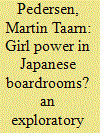

|
|
|
| 11 |
ID:
118641
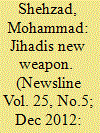

|
|
|
| 12 |
ID:
111562
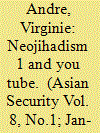

|
|
|
|
|
| Publication |
2012.
|
| Summary/Abstract |
This article examines the use of YouTube by the new generation of Patani 2
Muslim militants in their dissemination of propaganda and radical identity formation. These fighters have now brought their neojihadist war to the 'Virtual'. Videos of Patani shuhada and Buddhist beheadings are regularly posted on YouTube, with the aim of legitimizing their 'defensive jihad'. While most of the efforts in countering virtual terrorist radicalization have focused on jihadist websites, forums and blogs, very little attention has been paid to the relationship between the 'YouTube effect' and neojihadist violence. This article offers an analysis of the use of YouTube by the Patani Muslim insurgency in order to extract the ideological themes which enable us to understand the process of glocal neojihadist radicalization in southern Thailand.
|
|
|
|
|
|
|
|
|
|
|
|
|
|
|
|
| 13 |
ID:
155743
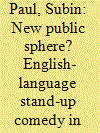

|
|
|
|
|
| Summary/Abstract |
The genre of English-language stand-up comedy is increasingly becoming popular in India’s metropolitan cities. This study uses the concept of the public sphere to examine YouTube videos of a prominent Indian live comedian, Daniel Fernandes. The analysis shows that Fernandes’ verbal humor is based on several performative techniques such as linguistic code-switching, calculative pauses, and juxtaposition of incongruous things. The study, furthermore, demonstrates that English-language stand-up comedy extends the bourgeois public sphere by a satirical commentary on political, social, and cultural issues in contemporary India as well as internationally. The article also argues that the public sphere exemplified by the genre of English-language live comedy is not entirely new, but an advancement of the classical public sphere.
|
|
|
|
|
|
|
|
|
|
|
|
|
|
|
|
| 14 |
ID:
104000
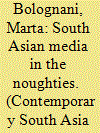

|
|
|
|
|
| Publication |
2010.
|
| Summary/Abstract |
This introductory note identifies the scope of this special issue as a challenge to predominantly technology-based analysis of media in South Asia. By exploring the ways in which specific power structures, multiple cultural and social milieus, and the flourishing of technological possibilities play out in the different case studies, these authors reject the view of media as an all-encompassing power by highlighting different cases where a disjuncture between technological progress and social or political change takes place. The textual and ethnographic studies of this volume show that media groups can only be successful in participating in social change if the audiences are already responsive or 'culturally intimate' with their contents. We are in favour, hence, of a social analysis that accounts for technological potential (mostly borrowed by the 'centre' of economic and technological global power) and its localised use.
|
|
|
|
|
|
|
|
|
|
|
|
|
|
|
|
|
|
|
|
|